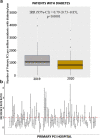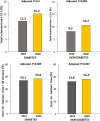Impact of COVID-19 pandemic and diabetes on mechanical reperfusion in patients with STEMI: insights from the ISACS STEMI COVID 19 Registry
- PMID: 33339541
- PMCID: PMC7747477
- DOI: 10.1186/s12933-020-01196-0
Impact of COVID-19 pandemic and diabetes on mechanical reperfusion in patients with STEMI: insights from the ISACS STEMI COVID 19 Registry
Abstract
Background: It has been suggested the COVID pandemic may have indirectly affected the treatment and outcome of STEMI patients, by avoidance or significant delays in contacting the emergency system. No data have been reported on the impact of diabetes on treatment and outcome of STEMI patients, that was therefore the aim of the current subanalysis conducted in patients included in the International Study on Acute Coronary Syndromes-ST Elevation Myocardial Infarction (ISACS-STEMI) COVID-19.
Methods: The ISACS-STEMI COVID-19 is a retrospective registry performed in European centers with an annual volume of > 120 primary percutaneous coronary intervention (PCI) and assessed STEMI patients, treated with primary PCI during the same periods of the years 2019 versus 2020 (March and April). Main outcomes are the incidences of primary PCI, delayed treatment, and in-hospital mortality.
Results: A total of 6609 patients underwent primary PCI in 77 centers, located in 18 countries. Diabetes was observed in a total of 1356 patients (20.5%), with similar proportion between 2019 and 2020. During the pandemic, there was a significant reduction in primary PCI as compared to 2019, similar in both patients with (Incidence rate ratio (IRR) 0.79 (95% CI: 0.73-0.85, p < 0.0001) and without diabetes (IRR 0.81 (95% CI: 0.78-0.85, p < 0.0001) (p int = 0.40). We observed a significant heterogeneity among centers in the population with and without diabetes (p < 0.001, respectively). The heterogeneity among centers was not related to the incidence of death due to COVID-19 in both groups of patients. Interaction was observed for Hypertension (p = 0.024) only in absence of diabetes. Furthermore, the pandemic was independently associated with a significant increase in door-to-balloon and total ischemia times only among patients without diabetes, which may have contributed to the higher mortality, during the pandemic, observed in this group of patients.
Conclusions: The COVID-19 pandemic had a significant impact on the treatment of patients with STEMI, with a similar reduction in primary PCI procedures in both patients with and without diabetes. Hypertension had a significant impact on PCI reduction only among patients without diabetes. We observed a significant increase in ischemia time and door-to-balloon time mainly in absence of diabetes, that contributed to explain the increased mortality observed in this group of patients during the pandemic.
Trial registration number: NCT04412655.
Conflict of interest statement
The authors declare that they have no competing interests.
Figures






References
-
- Li Q, Guan X, Wu P, Wang X, Zhou L, Tong Y, Ren R, Leung KSM, Lau EHY, Wong JY, Xing X, Xiang N, Wu Y, Li C, Chen Q, Li D, Liu T, Zhao J, Liu M, Tu W, Chen C, Jin L, Yang R, Wang Q, Zhou S, Wang R, Liu H, Luo Y, Liu Y, Shao G, Li H, Tao Z, Yang Y, Deng Z, Liu B, Ma Z, Zhang Y, Shi G, Lam TTY, Wu JT, Gao GF, Cowling BJ, Yang B, Leung GM, Feng Z. Early Transmission Dynamics in Wuhan, China, of Novel Coronavirus-Infected Pneumonia. N Engl J Med. 2020;382(13):1199–1207. doi: 10.1056/NEJMoa2001316. - DOI - PMC - PubMed
-
- Wood S. The Mystery of the Missing STEMIs During the COVID-19 Pandemic. tctMD. 2020. https://www.tctmd.com/news/mystery-missing-stemis-during-covid-19-pandemic. Accessed 2 Apr 2020.
-
- Garcia S, Albaghdadi MS, Meraj PM, Schmidt C, Garberich R, Jaffer FA, Dixon S, Rade JJ, Tannenbaum M, Chambers J, Huang PP, Henry TD. Reduction in ST-segment elevation cardiac catheterization laboratory activations in the United States during COVID-19 pandemic. J Am Coll Cardiol. 2020 doi: 10.1016/j.jacc.2020.04.011. - DOI - PMC - PubMed
-
- Tam CF, Cheung KS, Lam S, Wong A, Yung A, Sze M, Lam YM, Chan C, Tsang TC, Tsui M, Tse HF, Siu CW. Impact of coronavirus disease 2019 (COVID-19) outbreak on st-segment-elevation myocardial infarction care in Hong Kong, China. Circ Cardiovasc Qual Outcomes. 2020;13(4):e006631. doi: 10.1161/CIRCOUTCOMES.120.006631. - DOI - PMC - PubMed
-
- Piccolo R, Bruzzese D, Mauro C, Aloia A, Baldi C, Boccalatte M, Bottiglieri G, Briguori C, Caiazzo G, Calabrò P, Cappelli-Bigazzi M, De Simone C, Di Lorenzo E, Golino P, Monda V, Perrotta R, Quaranta G, Russolillo E, Scherillo M, Tesorio T, Tuccillo B, Valva G, Villari B, Tarantini G, Varricchio A, Esposito G. Population trends in rates of percutaneous coronary revascularization for acute coronary syndromes associated with the COVID-19 outbreak. Circulation. 2020 doi: 10.1161/CIRCULATIONAHA.120.047457. - DOI - PMC - PubMed
Publication types
MeSH terms
Associated data
LinkOut - more resources
Full Text Sources
Medical
Miscellaneous

